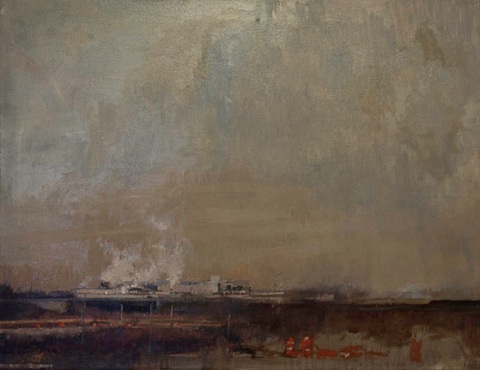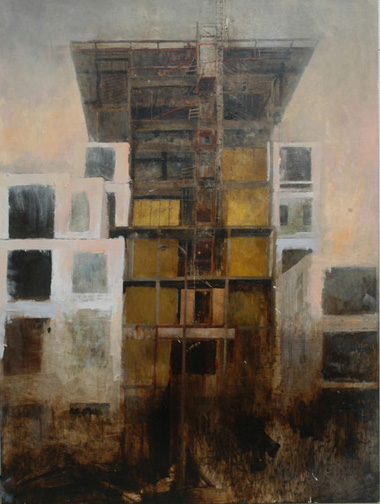Catherine Mulligan
November 8, 2014 § Leave a comment
“Painting is how I come to understand and articulate my feelings about existing in the world, to put it as broadly as possible. Uncertainties, insecurities, and unmet hopes or desires I aim to contain and resolve through a painterly language that is as often elegant and precise as it is awkward, sprawling, chaotic and clumsy. This mixture of dichotomies is meant to correspond to the actual confusion of categories I experience in both my emotional and aesthetic feelings, on a personal level; seeing the funny in the sad, the beautiful in the hideous and destroyed, the monumental in the minor. Using many carefully developed layers through under-painting, sanding, drawing and over-painting, I am both looking to masters like J. M. W Turner and attempting to illustrate the revised and shifting ways the world exists to me. Often, this world is that of the suburban strip-mall, and includes the detritus of modern life. My palette includes both pallid and pastel saccharine colors and harsher, more abrasive reds and oranges and browns. These are meant to evoke both the bodily earth tones and the more artificial color palette found in pop culture and advertising. Occasionally text (from a rub-on Letraset or my own hand) or ephemera fills in borders and relates uneasily, unclearly to the image depicted. Ultimately, my aim is to create paintings that serve as perhaps overly explicit accounts of experiences I’ve had (visual and psychological).”
Catherine Mulligan is exhibiting her work at F.A.N. Gallery in Philadelphia this month.
Rackstraw Downes
April 19, 2012 § 5 Comments
“When I… started painting from observation, one of the reasons was that I didn’t want to be so damn self-conscious about my paintings… Why not just look at something and paint it the way it is? Plop! And that’s what I did.
People often say to me, why do you pick such banal subjects, and I don’t understand that at all. They don’t seem to me to be banal in the least. They’re full of magic.
I came from a very flamboyant household, very theatrical – a very histrionic household. Everything was exaggerated; you never knew what anyone meant, and I didn’t like it. And I didn’t trust my own histrionics either, or strong affect, or whatever it is… in my paintings I try to get all that out and state it exactly – ‘no no, that’s not the way that air conditioner sits in that window. Do it again, Downes, and get it right this time, the way it really is!’ And I love that! I love feeling I have now got it, banal or not, I don’t care.
The detail comes in because you have to figure out how to move from here to here; then to here and to here… you make this block without any windows and you’re not sure whether it really is comfortably that size. As soon as you get those windows in there you get clearer and clearer and clearer about what it is. And in order to move about and keep these things in proportion I need all these things.
It’s my job to find places that answer to some internal need. I think that there’s this internal need before you get to the place and that the place answers the need.
…Could you paint a mountain without being sentimental about mountains, without falling victim to the mountain rhetoric; you know: look at this tremendous canyon, it’s so deep, and look at this terrifying crag up over your head, and all that business… I’m not interested in rhetoric at all.
I think that artists, or people who are active in another art form, even if it be writing or music… are often very, very perceptive critics of a different art form… a writer writing about painting or something, because they realize the limitations of criticism. Criticism can’t do everything, it can’t explain everything, and it can’t make certainties. There are no certainties in art.
There was a statement of Stendhal’s he wrote to his sister… “Only write on matters that you feel very strongly about. When you put them into words, try to do it as though you didn’t want anyone to notice.” I thought that was stunningly brilliant, and I felt exactly the same way.
I will say this… that all of us that are painters or artists or poets, or whatever it is, we spend quite a big chunk of every day doing the thing we really want to do. That cannot be said by lots of people.
– Rackstraw Downes, from video and interview by Betty Cunningham Gallery, 2007.
Randall Tiedman at the Ross Art Museum in February
December 29, 2011 § Leave a comment
“After many years of doing figurative work I have returned to doing landscapes. I use no photographs or reference material in my work. I have no preconceived idea other than a very general sense of where the painting is going. I rely on memory to generate ideas during process.
I have been greatly influenced by the Hudson River school with their sense of grandeur and stunning technique. However, I do not live in the Catskills among scenic hills and rivers which were so important to their work. I live in an industrial blue collar city with broken, fallen structures, rectangular pools, rusted girders and panoramic vistas of salt mines amidst steel factories and river barges. The city intertwines these elements with sports stadiums and office buildings among periodic breaks of lush greenery. The small tracks and roads intertwine to create a complex detail of the marriage of industry and city life. The iron bridges and petrochemical plants and office buildings have become my mountains amidst industrial ports that wind their way through this labyrinth of decay and rebuilding.
My work has been described as “dystopian,” or defined as commentary of ecological concerns. There is no conscious attempt by me to address concerns of the environment. I perceive the elements of light and dark generated by these vast panoramic scenes at night near dusk to be quite grand and it reflects my romantic sensibility. The only rule I insist on in these compositions is to maintain balance in the composition. The mind unconsciously craves that however intricate and involved a scene my be there must be a sense of harmony and balance in the compositional elements of a painting. In painting industrial landscapes, the painting becomes abstract in the sense that the pictorial logic becomes difficult to understand in a purely literal sense. The mix of roads, girders, and buildings intersecting become difficult to untangle as to where some edge of a building ends and a road begins, drawbridges interweave among utility poles cross-stitched among debris and discards from factories…”
-Randall Tiedman
Randall Tiedman’s paintings will be on exhibit at the Ross Art Museum on campus from February 14 to April 1. The artist will give a gallery talk at 4:15 p.m. on February 16.
“My Hometown” – Paintings of Rod Penner
October 22, 2011 § Leave a comment
“Now Main Street’s white-washed windows and vacant stores
Seems like there ain’t nobody wants to come down here no more
They’re closing down the textile mill across the railroad tracks
Foreman says ‘those jobs are going boys, and they ain’t coming back.’ “
– Bruce Springsteen, My Hometown
Springsteen’s song could be about almost any town in post-industrial-era America. One contemporary artist, Rod Penner, frankly confronts the banality of the changing suburban landscapes of America, making remarkable, often tiny, detailed paintings out of acrylic paint and his unprejudiced attention to what’s given.
Ryan Smith at Art Access Gallery, Columbus
January 21, 2011 § Leave a comment



































